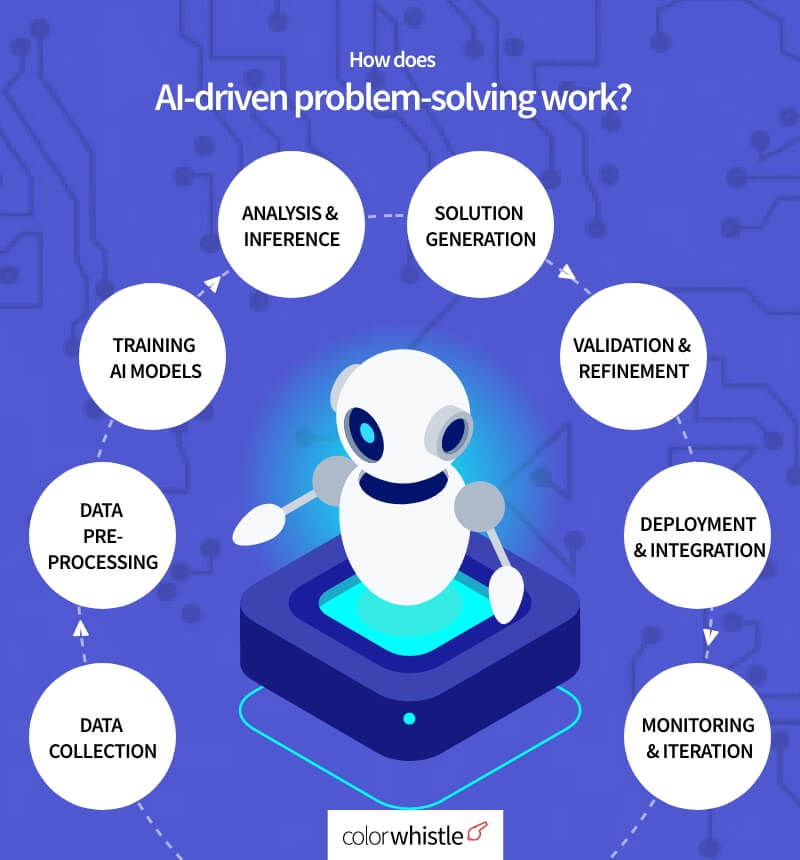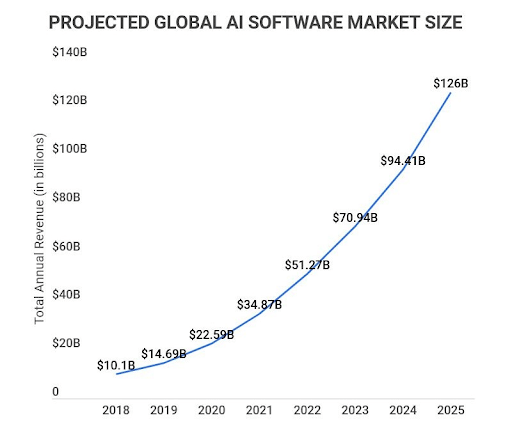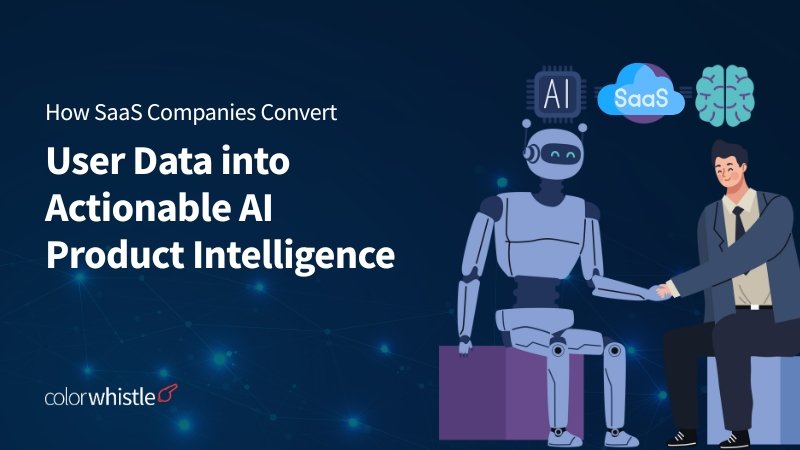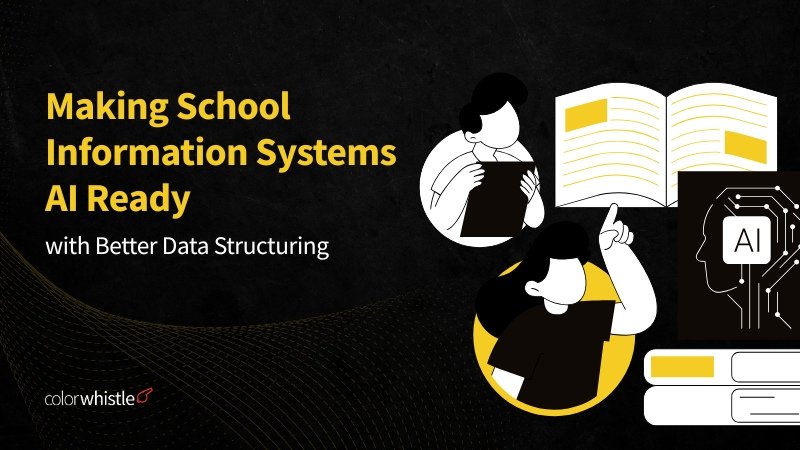“Identifying the Ideal AI-Driven Problem Solving Opportunities” involves the search for and selection of suitable challenges that can be effectively addressed using artificial intelligence (AI) technologies. AI-driven problem-solving encompasses the use of AI algorithms, machine learning, and other techniques to tackle complex problems and offer solutions beyond what traditional methods can achieve.
According to an article from TechJury, AI is currently being utilized by 35% of companies, while an additional 42% of companies are actively exploring AI for future implementation.

Let’s talk about Amazon’s Alexa or Apple’s Siri, One real-time example of how AI is attached to humans is through virtual voice assistants. These voice assistants utilize AI algorithms to understand human speech, interpret commands, and provide responses or perform tasks.
When a person interacts with a voice assistant, such as asking a question or requesting a specific action, the voice assistant uses natural language processing algorithms to analyze the spoken words and convert them into text. Then, machine learning algorithms and AI models analyze the text to understand the user’s intent and generate an appropriate response or execute the requested action.

For example, a user could inquire of their voice assistant, “Could you provide me with today’s weather conditions?” The voice assistant utilizes AI algorithms to handle speech input, convert it into text, analyze the query, and fetch pertinent weather data according to the user’s location. The voice assistant then provides the user with a spoken response, such as “Today’s weather in your area is partly cloudy with a high of 75 degrees.”
This example illustrates how AI is attached to humans through voice assistants, enabling us to interact with technology using natural language and receiving personalized responses or performing tasks, enhancing convenience and efficiency in our daily lives.
Also Read
What is AI-driven problem-solving?
AI-driven problem-solving uses artificial intelligence (AI) to analyze data, identify patterns, and provide effective solutions to complex problems. It involves training AI models with relevant data, generating solutions based on analysis, and validating their effectiveness. This approach complements human decision-making by offering data-driven insights. However, ethical considerations and transparency are vital for responsible AI implementation.
Did you know?
By 2027, the projected value of the worldwide AI market is estimated to reach an impressive $407 billion.
How does it work?
AI-driven problem-solving works by leveraging various AI techniques and algorithms to process data, analyze patterns, and generate solutions.
Data Collection
Data that carries essence is compiled from a pack of sources, including databases, sensors, and online platforms. This data can be structured (e.g., numerical data) or unstructured (e.g., text, images, videos).
Data Preprocessing
The collected data is cleaned, transformed, and organized to ensure its quality and compatibility with AI models. This step involves clearing noise, handling missing values, and standardizing the data format.
Training AI Models
The preprocessed data is used to train AI models, which can include machine learning algorithms like neural networks, decision trees, or support vector machines. During training, the models learn to recognize patterns and connections within the data.
Analysis and Inference
Once the AI models have undergone training, they can examine fresh data by leveraging the acquired patterns to make predictions or decisions. This analysis contains various tasks, including classification, regression, clustering, and natural language processing.
Solution Generation
The AI models develop solutions to the given problem based on the analysis and inference performed. These solutions encompass a range of outputs such as recommendations, optimizations, predictions, and more, tailored to the specific problem domain.
Validation and Refinement
The generated solutions are evaluated and validated to assess their accuracy and effectiveness. If necessary, the AI models can be refined by retraining them with updated data or adjusting their parameters to enhance their performance.
Deployment and Integration
After validating the AI models, the next step involves deploying and integrating the generated solutions into existing systems or processes. This may require the development of user interfaces, APIs, or other mechanisms to ensure that the AI-driven solutions are accessible and usable by stakeholders.
Monitoring and Iteration
AI-driven problem-solving is an iterative process. The deployed solutions are continuously monitored to ensure they perform as expected and remain up-to-date. Feedback from users and ongoing data collection can be used to refine and improve the AI models over time.
It’s important to note that the specific details of how AI-driven problem-solving works can vary depending on the problem domain, the available data, and the chosen AI techniques. Additionally, ethical considerations, transparency, and interpretability should be taken into account throughout the entire process to ensure responsible and trustworthy AI implementations.

Also Read
Several areas and applications where artificial intelligence can be effectively utilized for problem-solving
Healthcare
Think how easy it would be if someone made it easy for you to get healthcare access at a low cost without much effort. Will you ever say no?
AI can. Yes! AI can aid in medical diagnosis, drug discovery, personalized medicine, and patient monitoring. It can analyze medical images, electronic health records, and genomic data to provide accurate diagnoses and treatment recommendations.
Take a look at how digital healthcare improves patient outcomes and famous healthcare providers’ business growth – Most Popular Healthcare Apps & Features.
Finance
AI algorithms can analyze financial data, detect patterns, and make predictions for investment decisions, risk assessment, fraud detection, and algorithmic trading. It helps improve portfolio management and optimize financial processes.
It is also transforming the finance industry by automating tasks that were traditionally performed by humans. Analyzing financial data and forecasting trends and patterns empowers traders to make informed investment decisions, minimize risks, and optimize their strategies.
Customer Service
By 2020, the adoption of AI as a customer service solution is anticipated to reach a staggering rate, with approximately 80% of businesses having either implemented or planning to implement AI.
As we have progressed three years beyond 2020, considerable AI and machine learning projects have emerged and found practical applications. Among them, AI-powered chatbots and virtual assistants have become prevalent in customer service. These intelligent systems excel at automating customer support, addressing inquiries, and resolving common issues. By comprehending natural language, they efficiently assist customers, providing prompt and effective solutions.
Did you know?
According to projections, by 2025, artificial intelligence (AI) is expected to be responsible for 95% of customer experience enhancements.
Transportation
Machines equipped with AI capabilities have the ability to imitate humans, automate manual tasks, and continuously learn, much like their human counterparts.
These innovative digital solutions excel in optimizing traffic flow, route planning, and logistics, including the realm of self-driving vehicles and drone taxis. By enabling real-time traffic prediction, facilitating autonomous vehicles, and managing transportation network through a centralized routing platform, they contribute to enhanced efficiency and minimized congestion, revolutionizing the way we navigate and transport goods and people.
Manufacturing
In the manufacturing sector, AI refers to the application of machine learning (ML) solutions and deep learning neural networks. These advanced technologies are utilized to improve manufacturing processes through refined data analysis and more informed decision-making.
It enhances automation, quality control, and predictive maintenance in manufacturing processes. It can analyze sensor data, optimize production lines, and identify potential equipment failures, improving productivity and reducing downtime.
Environmental Monitoring and Agriculture
AI is also employed in the surveillance and prevention of illegal wildlife trafficking, and data analysis to detect patterns, and pinpoint wildlife crime hotspots.
It enhances disaster response and management by utilizing sensor data and other sources to identify high-risk regions for natural disasters like floods or wildfires, enabling timely warnings and proactive measures. It helps with climate modeling, air quality analysis, and ecosystem monitoring.
AI optimizes crop yield, irrigation, and pest control by analyzing soil data, weather patterns, and crop health. It assists in precision agriculture, plant disease detection, and automated farming processes.
Education
AI can personalize learning experiences, offer intelligent tutoring, and provide adaptive assessments. It helps track student progress, identify areas of improvement, and deliver tailored educational content.
Cybersecurity
AI can detect and prevent cyber threats by analyzing network traffic, identifying anomalies, and predicting potential attacks. It aids in threat detection, behavior analysis, and proactive security measures.
Also Read
Benefits of AI Adoption
- Increased Efficiency
- Enhanced Productivity
- Improved Accuracy
- Personalization and Customer Experience
- Cost Savings
- Advanced Decision Support
- Innovation and New Opportunities
- Improved Safety and Risk Management
- Scalability and Adaptability
- Scientific and Medical Advances
Looking for AI Consulting Services?
Seize and experience the transformative impact of your business with ColorWhistle’s AI Consulting Services.
Wrapping Up
Identifying ideal AI-driven problem-solving opportunities is crucial for leveraging the power of artificial intelligence effectively. By following a systematic approach and considering factors such as data availability, feasibility, and ethical considerations, organizations can harness AI’s potential for innovative solutions.
AI-driven problem-solving finds applications across industries like healthcare, finance, customer service, transportation, and manufacturing, offering benefits such as improved efficiency and accuracy. Responsible adoption of AI, including ethical considerations and transparency, is important. Embracing AI-driven problem-solving opens doors to innovation and competitive advantage, shaping a better future.
Browse through our ColorWhistle page for more related content and to learn about our services. To get in touch with us and learn more about our services, please visit our Contact Us page.
What’s Next?
Now that you’ve had the chance to explore our blog, it’s time to take the next step and see what opportunities await!
Read Similar Content
Wish to Explore Our Services?
Have an Idea? or Project Scope?
In quest of the Perfect AI Consulting Services Buddy?
Be unrestricted to click the other trendy writes under this title that suits your needs the best!
- AI in Social Media: Statistics and Trends Driving Content Creation [Facts + Insights]
- 3D Car Configurators, VR & AR-Enabled Online Sales: Revolutionizing the Future of Car Shopping
- Invest in 3D Digital Journey to Visualize, Customize, or Virtual Try-On Jewelry & Watches
- Beyond Words: Exploring Multimodal AI Content Creation [Statistics + Insights]








